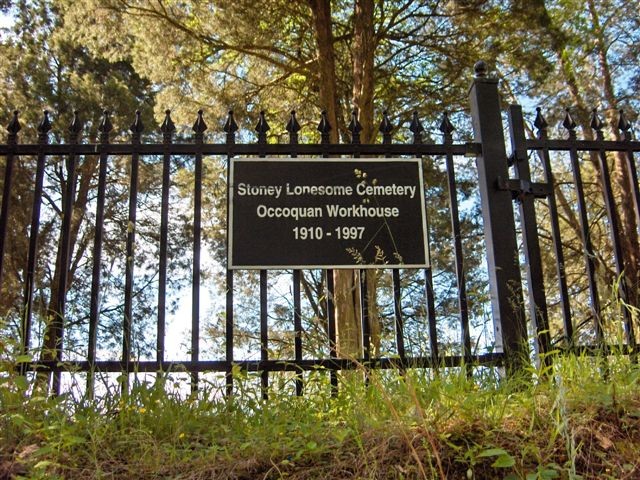Stoney Lonesome Cemetery, Occoquan Workhouse
Introduction
Text-to-speech Audio
Images
Stoney Lonesome Cemetery sign, courtesy of Workhouse Museum (reproduced under Fair Use).

Backstory and Context
Text-to-speech Audio
The original prison was established in Lorton in 1910. Several names were applied to this facility, officially called District of Columbia Workhouse and Reformatory, including Lorton Prison and District of Columbia Correctional Facility. It was a minimum-security prison originally, though later a maximum-security facility and juvenile detention facility also developed on the complex. Another part of the facility was the Occoquan Workhouse, which violently detained suffragists in 1917. The Workhouse Arts Center/Workhouse Prison Museum that now exists on the site depicts this history.
Disease, such as the Spanish flu epidemic of 1918, and workplace accidents occasionally felled inmates during their incarceration. Prisoners who died while incarcerated were not automatically buried in the Stoney Lonesome cemetery, only those whose relatives did not claim them. Fellow inmates attended funerals, which were overseen by local clergy or the prison's chaplain. Graves were dug by hand, usually by an inmate, and the coffins were pine boxes built in the prison's carpentry shop.
The cemetery is situated just north of the defunct prison complex along what is now an access road owned by the Fairfax Water Authority. It stands in a grove of cedar trees and is surrounded by a wrought-iron fence. Burials were laid out in north-south rows each containing 10-14 burials, and are discernible as depressions in the ground. A few rough grave markers are in place, but they do not contain identifying information on those individuals buried here.
Sources
Clifton, Irma. Lorton History -- Lonesome Cemetery, Workhouse Prison Museum at Lorton. Accessed December 16th 2019. https://workhousemuseums.org/media/articles/lorton-history-lonesome-cemetery/.
eazyeschendor. Stoney Lonesome Cemetery, Atlas Obscura. Accessed December 16th 2019. https://www.atlasobscura.com/places/stoney-lonesome-cemetery.
Stoney Lonesome Prison Cemetery, Find a Grave. July 25th 2006. Accessed December 16th 2019. https://www.findagrave.com/cemetery/2183297/stoney-lonesome-prison-cemetery.
http://workhousemuseums.org/media/articles/lorton-history-lonesome-cemetery/
